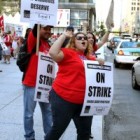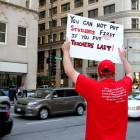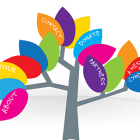
Sites, Sounds from the Chicago Teachers’ Strike
|
By Audrey Cheng and Jennifer Starrs
Emotions and rhertoric have been running high as CTU teachers and paraprofessionals formed picket lines, beginning early Monday and continuing Wednesday with no quick end in sight for the first schools strike since 1987. Teachers are pushing for a contract, better working conditions and more social workers in schools, amomg other issues – while administration officials are pressing for big curricular and testing changes, including a greater emphasis on programs like charter schools.
Audrey Cheng and Jennifer Starrs are reporters for The Chicago Bureau.

